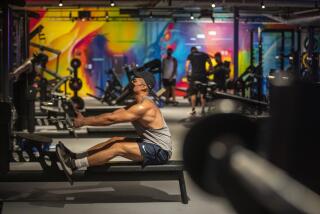For the Athlete, It’s a Bit of Heaven : Yale’s Gym Has 14 Floors of Wall-to-Wall Physical Fitness
NEW HAVEN, Conn. — They call it “the cathedral of sweat,” or “the gym for all reasons.”
The Guinness Book of Records lists it as the largest gym on earth.
The 53-year-old, 14-story Payne Whitney Gymnasium is a monument to Yale University’s commitment to physical fitness.
You would never look at the opulent Gothic sandstone structure and say, “Oh, there’s the gym.”
Strangers on campus usually remark: “Look at that beautiful church.” It’s designed after the Liverpool cathedral in Liverpool, England.
Every day an average of 4,000 students, faculty and staff suit up at Payne Whitney for a variety of sports somewhere on one of the 14 floors, in the basement or sub-basement.
Basketball, wrestling, fencing, track, swimming, water polo, volleyball, rowing, squash, polo, ballet, yoga, aerobics, racquetball, handball, soccer, gymnastics, karate, judo, table tennis, rugby, lacrosse, weight and exercise classes and much, much more take place in the giant gymnasium. There is even a golf driving range.
In bad weather, rowers come inside and do their rowing in three tanks in Payne Whitney. Water is pumped past the rowers at seven knots an hour, simulating the current in the Housatonic River and generating whitecaps in the tanks.
The 15-meter practice pool on the third-floor holds 350,000 gallons of water and is the largest above-ground swimming pool in the world.
On the ground floor, the Robert Kiphuth Memorial Exhibition Pool Stadium seats 3,000.
Two polo rooms in the gym are the first of their kind anywhere. The polo player mounts a leather-padded wooden horse bolted to the floor. The horse is surrounded by padded walls, and a sloped floor returns the ball to the rider’s side.
For years, freshmen at Yale had to pass a posture test or attend corrective classes in the Payne Whitney posture room.
Walls of the gym are lined with photos of Yale athletes and intermural sports club members dating back to the 1880s. Currier and Ives lithographs of cricket, horse racing, boxing, basketball and volleyball also decorate the gym.
The building is open from 6:30 a.m. to midnight.
No credits are given for physical education programs, but classes are nearly all filled to capacity. To use the gym, each student, faculty and staff member has to register.
Payne Whitney has 11,000 registered members. Students pay $22 a year for use of locker and towels.
“This place grows on you,” said Jack Knight, 40, building supervisor. “There’s a real sense of history here.”
History and tradition are part and parcel of Yale, which was founded in 1701 and is the third-oldest university in the country.
America’s oldest intercollegiate athletic event, the Harvard-Yale crew race, has been an annual occurrence since 1852.
In 1969, a lot of changes were made in Payne Whitney when women came charging through the gym’s massive glazed-oak doors for the first time. That was the year women were admitted to undergraduate classes at Yale.
Times change. Today the school’s assistant director for athletics and administrator of the gym is Anita Carrieri, 54, a transplanted Southern Californian.
Completed in 1932 the gymnasium is a memorial to Payne Whitney, BA 1898, the gift of his wife and children, Mrs. Charles Shipman Payson and John Hay Whitney, BA 1926. It cost $5.5 million to build 33 years ago.
